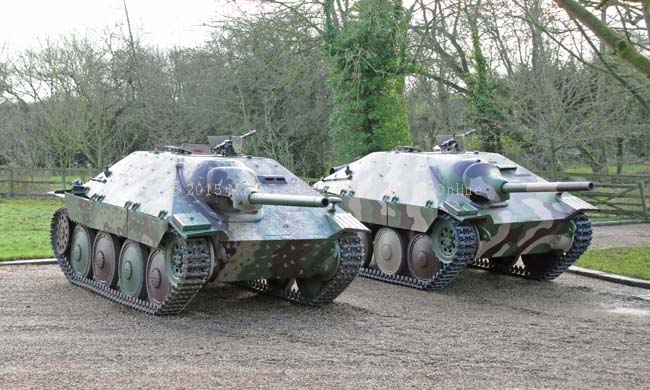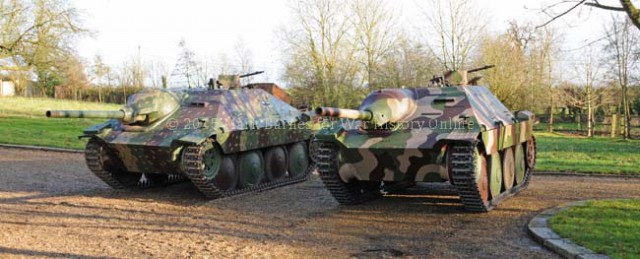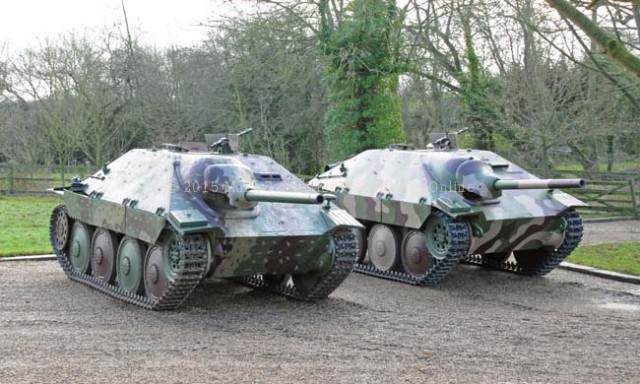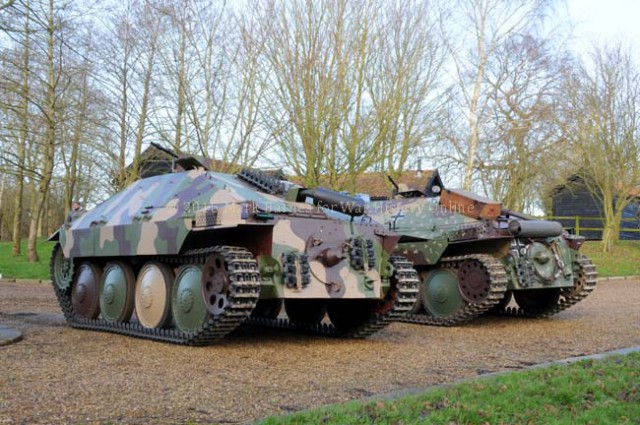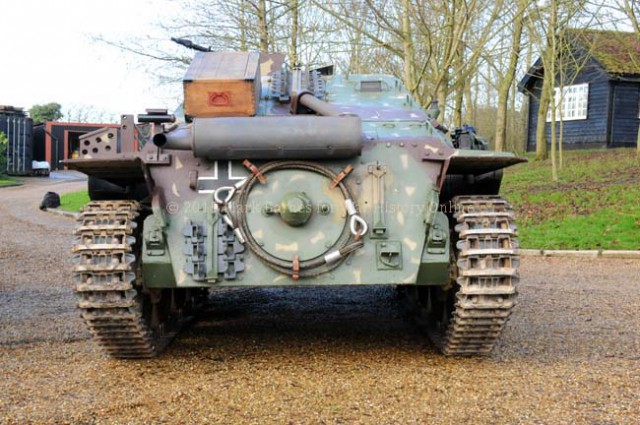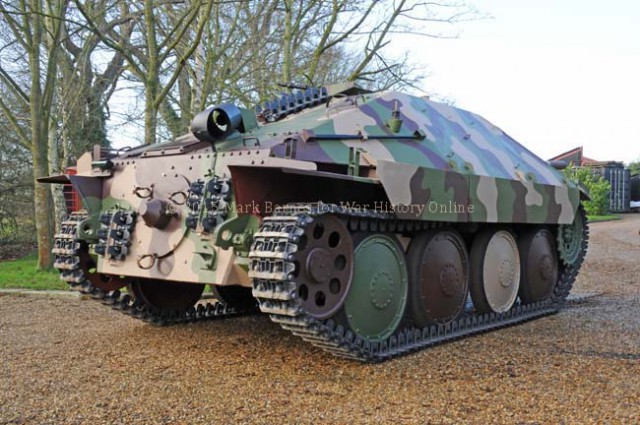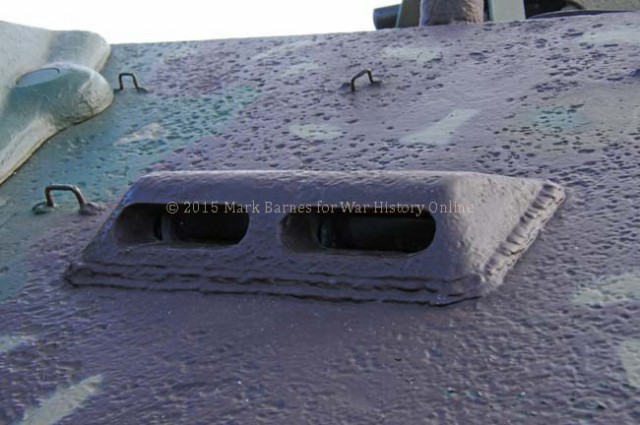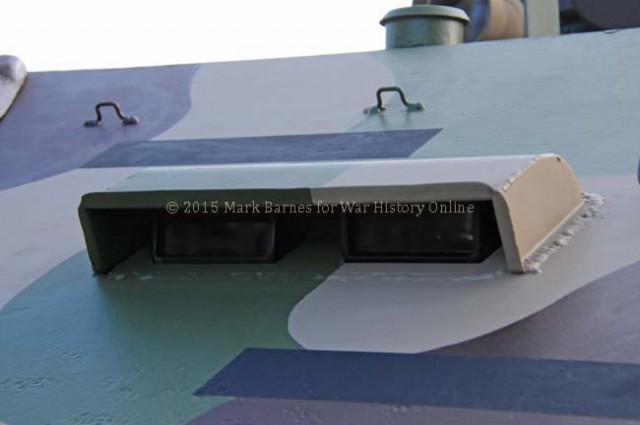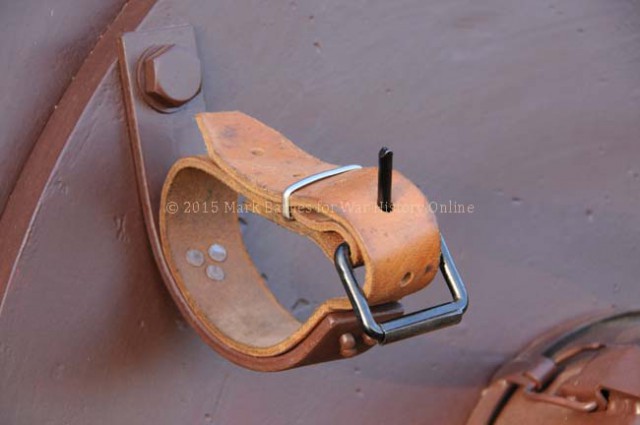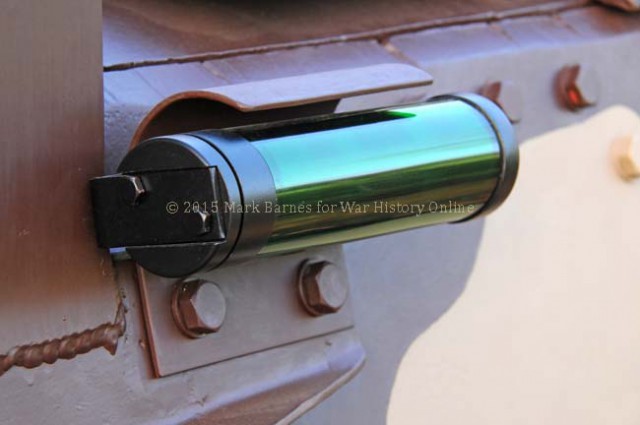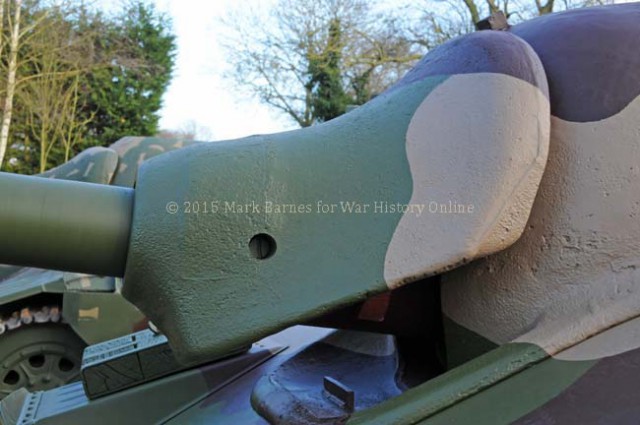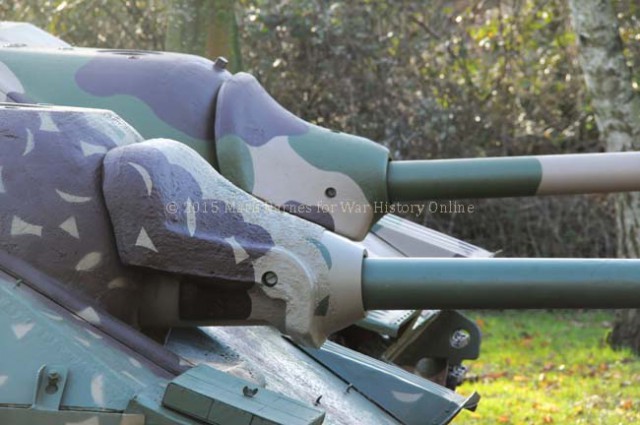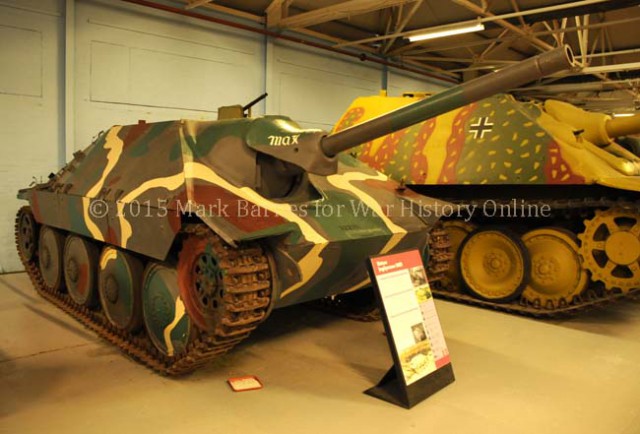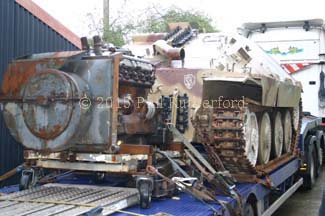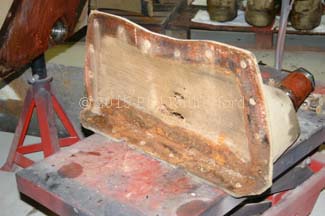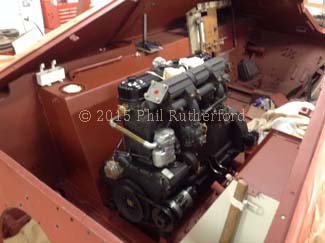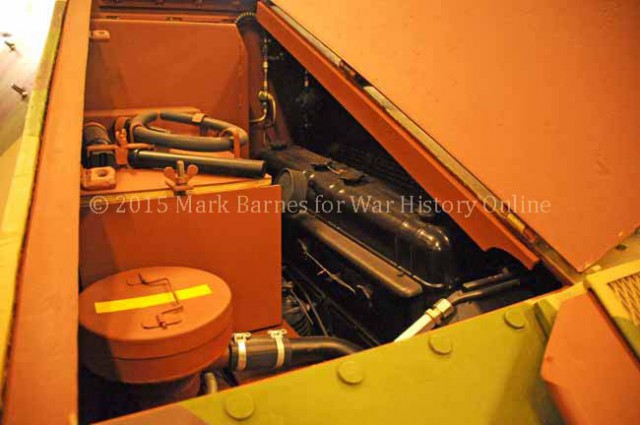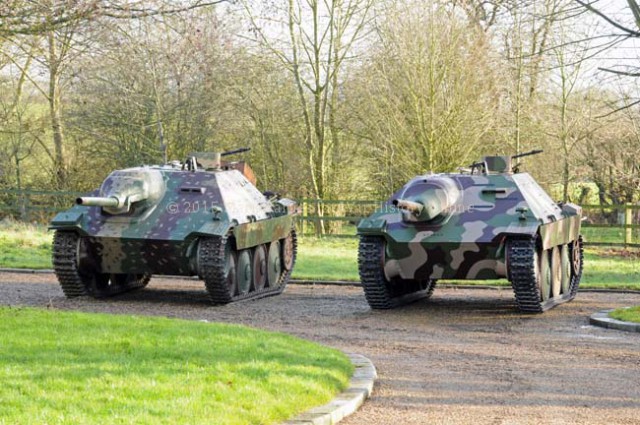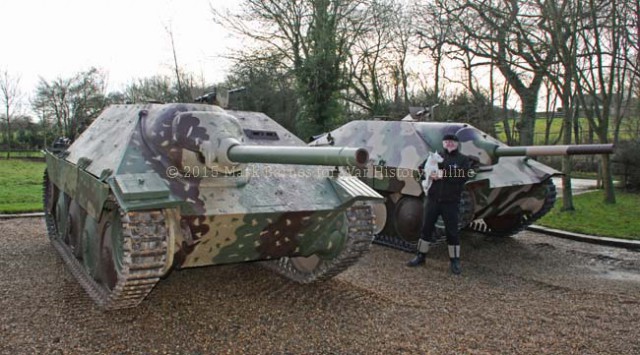Mark Barnes pays a visit to Axis Track Services to see an Aussie bound Hetzer alongside one that seems quite happy where it is.
After a meticulous three-year restoration a 1945 Sd.Kfz. 138/2 Jadpanzer 38 Hetzer has been completed by Axis Track Services and the vehicle is ready for the long journey to Cairns in Australia where it will join the growing collection of the Australian Armour & Artillery Museum.
We were invited to see a special event when the Hetzer was paired with the vehicle owned by Bruce Crompton who believes this will be one of the very few, if not the only, occasions there are likely to be two genuine wartime Hetzersside by side.
Front and rear views of the pair.
Visit any number of museums or get yourself on the show circuit and it quickly becomes apparent that there are a fair number of Hetzers about but the vast majority of them are actually post-war Swiss G-13 models that have benefited from a bit of a tart up to look like WW2 German examples. Skoda were still producing them at the very end of the war and continued to do so after, but by this time specifications had changed a great deal, none more so than on the Swiss G-13s which are almost entirely different from their German cousins.
Rear views show differences in the exhaust system and other details of the earlier model (top) and the newly restored late vehicle.
As an aside, it is generally accepted that the name Hetzer, meaning Baiter, was never in official use during the war but it is apopular name given by troops and this acquired permanency in the aftermath of World War II.The vehicle was a progression from the Marder III tank-destroyer that was also based on the 38(t) tank chassis of Czech origin but suffered from having a higher profile and open gun deck. Whereas the somewhat slab sided Marder III was 2m 48cm/8ft 2ins tall, the Hetzer came in at 2m 17cm/7 ft 1 ins and it benefited from being enclosed with a shape something not unlike a tortoise with armour sloping at 15 degrees. This made the Hetzer five tonnes heavier than the Marder III, weighing in at around 15.75 tonnes or 34,000lb.
The drivers vision slit on the early model proved to be a shot trap so later vehicles were fitted with a flush periscope. One of the fake black vision slits added to deceive the enemy is clearly visible.
The Hetzer proved easier to manufacture than bigger and more elaborate counterparts like the Jagdpanther and although it went through the typical blend of modifications that beset so much of German armoured vehicle production it proved to be solid, reliable and potent for its size and armament. Over 2,500 of all variants are known to have been built.
The vehicle bound for Australia was built in either January or February 1945 and didn’t travel very far before it was knocked out near Prague and sent back to the factory to be rebuilt. The serial number 323437 dates manufacture to this period and clearly shows that the vehicle is a wartimeHetzer and not a post-war build. With the war over the vehicle became part of the G-13 programme undergoing the plethora of alterations that make it so different from the original.
The Hetzer was deactivated at the end of its service life with the Swiss by removing the engine and filling the bay with concrete. Fortunately this was first lined in plastic sheeting and although getting it all out must have been a hell of a job, without the lining it would have been practically impossible to remove. A length of railway sleeper was used to reinforce the concrete. In addition to this the deactivation progress naturally involved doing some brutal things to the gun to render it useless. On completion the Hetzer became part of a museum collection in Germany where it was given a slap of paint and a whitewash to create the desired effect.
Once the Hetzer arrived at Axis Track Services the long task began to return the vehicle to original World War II specification. The concrete and timber in the engine bay was removed by breaking it up with a Kango and the G-13 spec kit was stripped out, including the gun and pretty much everything else. As you might expect a great deal of time and effort went into sourcing original components and when none were available new ones were made. It is quite appropriate that some of the restoration work was done in the Czech Republic, where the gearbox was sent for rebuilding.
The devil is always in the detail. These shots of the rear light and one of the straps on the back of the vehicle illustrate what a meticulous restoration this is.
The gun mounted in the Hetzer was not the correct PaK 39 and a replacement had to be found. The problem there was so many missing fittings were impossible to source and these had to be made from scratch. One thing that struck me about the interior was the amount of provision made for storing ammunition that needed to be crammed in every spare space to store forty rounds inside. The crew would line the floor space with them and would literally be standing on shells while they worked. There is no system to eject spent rounds and, more worryingly, the only way to get out of a Hetzer in a hurry is through the roof hatch. Floor hatches were not built into the design until they appeared on relatively few examplesvery late in the day. If one of these vehicles was tipped over there was little chance of escape for the crew.
There are obvious differences in the early and late‘Saukopfblende’.
External differences between early and late Hetzers are quite apparent and I was fortunate to be able to compare them on the project vehicle with Bruce Crompton’s own example that was built in 1944. We can start with the gun shields that are markedly different in shape. The later Hetzer’s is known as the Saukopfblende (usually translated as ‘pig’s head”) and is bigger than its older brother. The raised drivers vision slit on the first Hetzers was found to be a something of shot trap creating all manner of issues for the crew. The later vehicle is fitted with a flush periscope and you will note from the photographs that fake vision slits were painted on to the hull to confuse opponents targeting the vehicle.
This BMM manufactured Jagdpanzer 38 is on display next to its larger cousin, the Jagdpanther, at the Tank Museum, Bovington.
The team had access to the original Hetzer on display at the Tank Museum, Bovington, to use for reference. This vehicle represented something of a time capsule because it had not been opened for access in several decades.
Engineer Phil Rutherford explained a great deal about the restoration over tea and very kindly provided us with photographs from stages of the project. It made sense to ask him to describe what is happening in his own photos!
The day of the Jagdpanzer’s arrival from Germany in the guise of a G-13 complete with its post war Deisel V8. The V8 had only 380k on its record slip which was neatly stored in an aluminium tube attached to the engine, the tank had hardly done anything in its post war configuration.
There are two ways tanks from Europe are deactivated, either holes are cut in the hull, usually around the drivers position, or as with this one, luckily, the engine is removed, the engine mounts are cut off and the entire engine bay is filled with concrete, about two cubic meters in our case. Someone had been a bit clever and laid plastic sheeting inside first, which did prevent the lime in the cement doing too much damage, but it still took a full day to break it all out.
The L40 post war gun was removed early on in the restoration to make way for the correct wartime L39 gun later. Just a few parts of the post war gun are interchangeable, such as the mantlet (with modification) and the Saukopfblende all of the remaining gun is either original or reproduction copied from the main gun in Bovington’s Jagdpanzer 38. This was quite a task in itself, but well worth it. The biggest give away of this tank’s G-13 past was the post war main gun, so changing it to the correct wartime version was imperative.
As with the rest of this restoration, attention to detail inside was very important. Bovington’sJagdpanzer 38 was invaluable here. A great misconception is that all wartime Jagdpanzer 38s were all the same inside, not true. Early versions had all manner of accessories, such as gas mask holders and spare tube holders dotted around, later versions were much simplified inside, because of the relatively short period of production many changes took place over its manufacture, at one period such as Bovington’s BMM Jagdpanzer 38, an instruction to not paint the interiors white was given, just left in Red Oxide, which, one month later was revoked due to crews complaining they couldn’t see what they were doing. To fill the ammo racks, 41 dummy rounds were produced, moulded and then painted from original ones. With all the stowage boxes and ammo boxes scattered around the floor in their correct positions there is very little room for the four-man crew and the compartment is very tight, the driver would have been easily trapped, should the tank sustain a hit.
On removing the wheel stations we discovered a sacking gasket coated with sealant used to seal the unit to the hull, this we replicated when they were replaced. The drive units were in great shape, but the G13 was modified post war to run oil in the drive units, fairly unsuccessfully as they were very leaky. We put the whole unit back to wartime spec, all running in grease, this meant discarding the two oil fillers on the front of the drive units.
The hull back on its road wheels, a lot of postwar Jagdpanzer 38’s suffered with the wheels braking up under hard use, so small welds were place around the rims to hold them together. As this was a postwar mod we removed them from these wheels. The paintwork had to be very precise, to reflect the period of this tank, all Jagdpanzer 38s had their cammo applied at the factory, and this being a late vehicle we used original photos to give us the information we needed. Using the three main pre 1953 classic RAL colours the cammo layout was first drawn on in chalk, then painted in by brush as it would have been at the factory, similar to painting by numbers!
The engine installed, here this was the newly rebuilt 6 cylinder petrol unit, we were lucky to have a spare damaged engine to use as a mockup to position all the new engine mounts. The engine compartment on Bovington’sJagdpanzer was cut open by special arrangement, the first time in 50 years, to reveal a time capsule of detail which we documented extensively, as opportunities like that don’t come up too often. This information was really useful a enabled us to add all the correct layout to all the components throughout the engine bay.
All Jagdpanzer 38s had a factory fitted canvas roof cover fitted, this was vital to keep the rain out when being transported or awaiting delivery at the factory. The roof on these tanks leak really badly which isn’t pleasant for the crews, although many of these covers were lost or damaged. We felt it well worth fitting one to this Jagdpanzer especially as it’s going to spend a long time being shipped to Australia, and it’s another important detail that has a practical advantage.
Cheers Phil!
The result is clearly another immensely impressive achievement by the folks at Axis Track Services. They admit to being sorry to see the Hetzer go after so much time working on it. As always, we received a warm welcome in Suffolk and had the chance to see Bruce filming an instalment of the next series of Combat Dealers.This all helped brighten up a freezing cold East Anglian day.
The Hetzers make for a fantastic sight and were an obvious subject for an upcoming segment of Bruce Crompton’s successful ‘Combat Dealers’tv show.
We would like to thank everyone at Axis Track Services for their hospitality and assistance with this feature. Visit their website at www.axistrackservices.com or follow them on Facebook. The new series of Combat Dealers will be shown on Quest later this year. You can check out the Australian Armour and Artillery Museum at www.ausarmour.com
